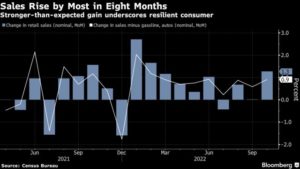Augusta Saraiva
BloombergNovember 16, 2022
Nine of 13 retail categories rose last month, according to the report, including firm results at auto dealers, grocery stores and restaurants. The value of sales at gas stations climbed 4.1%, mostly reflecting higher pump prices.
The data illustrate that consumers are continuing to prove largely resilient and suggests the economy got off to a good start in the fourth quarter. That may complicate the argument posed by several Federal Reserve officials pushing for a slower pace of interest-rate hikes in the coming months, but policymakers acknowledge that inflation is still far too high.
Consumer and producer price growth both eased by more than forecast last month, spurring a rally in stock and bond markets in hopes that the Fed will downshift to smaller hikes as soon as December. After Wednesday’s retail report, two-year Treasury yields rose and US stock futures remained lower.
Even though some price pressures are easing, retailers are still seeing the impact of inflation in earnings. Home Depot Inc.’s profit exceeded expectations last quarter, but was driven by higher prices rather than more transactions. Walmart Inc., meanwhile, raised its full-year guidance as US shoppers flocked to its stores to find discounts.
‘Increasingly Impacted’
At the same time, Target Corp. warned that shoppers are pulling back, “with guests’ shopping behavior increasingly impacted by inflation, rising interest rates and economic uncertainty,” Chief Executive Officer Brian Cornell said in a statement Wednesday.
Many retailers, stuck with a glut of inventory, have deployed deep discounts to try to move stock off their shelves for the crucial holiday season. Sales at clothing stores were little changed while those at department stores fell 2.1%. Other discretionary categories like electronics and sporting goods also declined, suggesting price cuts and weaker demand are weighing on the value of sales.
Besides not being adjusted for price increases, the retail sales report only captures a sliver of services spending, where Americans have been shifting more of their dollars. A fuller picture of October household demand, which includes both services spending and inflation-adjusted figures, will be released in two weeks.
So-called control group sales — which are used to calculate gross domestic product and exclude food services, auto dealers, building materials stores and gasoline stations — increased 0.7% in October, the most in four months.

